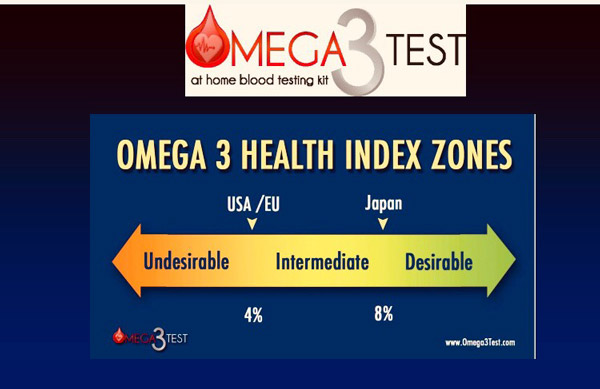Protect Your Valentine’s Heart with an Omega 3 Blood Test

When Gary’s cholesterol was found to be elevated way back in 1999, my Ironman blue eyed rock husband had a calcium scan to “get his dietitian wife off his back” and was surprised that his calcium score of over 1000 signified “very high risk of an event with a predicted 10 year chance of an event at 37%. How could an Ironman have such a high calcium score? And, so we began our journey to keep Gary’s heart healthy so he can live his giant and fabulous bucket list. This led me to the Holman Omega 3 Blood Test.

First let’s talk about the different fatty acids.
Omega-6 and omega-3 fatty acids are considered essential fatty acids (EFAs) because we cannot make them, so we must consume them. We need both omega-6 and omega-3 fatty acids. Omega-6 and omega-3 fatty acids are used to make certain types of hormones or chemical messengers, and play critical roles in immune and inflammatory responses in the body. They are components of nerve cells and cell membranes, which affect every cell and tissue having an impact on cancer (tumor progression), heart and blood vessel function, immune function, depression and brain health, bone health, reproductive health, skin and hair and more.

Hormones are the way our body communicates and functions. The long chain omega-3 fatty acids EPA, DPA and DHA help to regulate blood pressure, blood vessels and inflammation to promote a healthy heart. Studies show omega-3 fatty acids also may help to protect against lupus, eczema, rheumatoid arthritis and cancer. (1)
Both omega-6 and omega-3 fatty acids have health benefits, but omega-6 metabolites are more reactive than omega-3, and can become more aggregatory if not balanced with omega-3 fats. Many scientists hypothesize a diet high in omega-6 and low in omega-3 fatty acids will increase inflammation, while a diet that includes balanced amounts of each helps to reduce inflammation. (2)
Chronic inflammation is a leading driver of the most serious diseases including diabetes, arthritis, heart disease, metabolic syndrome, arthritis, Alzheimer’s and many types of cancer. The typical American diet can often contain 25 times more omega-6 fatty acids than omega 3 which may be why we are seeing more people with chronic inflammatory health issues.
Ratio of Omega 6 to Omega 3
People always ask how much omega 3s they should eat. It depends on how much omega 6s you are eating. An omega 6 to omega 3 ratio of 4:1 is ideal that’s 4 omega 6s for every 1 omega 3. The average American eats of ratio of 12:1 to 25:1 omega 6 to omega 3. Way! Too! High! Why so high? The most common source of omega 6s is linoleic acid found in corn oil, soybean oil, safflower oil, cottonseed oil, sunflower oil, poultry and some nuts and seeds. They are very cheap to produce so many food companies use them in processed foods like frozen pizza, margarine, dairy creamer, popcorn, granola, crackers, cookies and candy.
How do you reduce your omega 6’s?
- You eat less processed foods in wrappers.
- You can eat fewer processed vegetable oils.
- You can eat more colorful foods including lots of vegetables, healthy grains and protein.
- You can cook most of your meals.
- You limit your fast food and convenience food.
- You can give attention to what you eat not mindlessly eat “food that comes by.” (As a clinical RDN I heard this several times each day.)

Gary and I were tested in 2016 and again in 2018. His 2018 test showed a higher % omega 3and a lower % of omega 6. I attribute this to our minimal eating of processed foods, higher fish consumption (he eats salmon every morning for breakfast along with Greek Yogurt, cereal and berries) and fish oil supplements.
Disclosure: I was provided two Holman Omega 3 Tests for Gary and myself, but my opinions and ideas about omegas and heart disease are my own.
Coronary Heart Disease and Tissue Highly Unsaturated Fatty Acids

Most of the imbalances we see are a result of a nutrient deficient diet. Research suggests that a large number of Americans carry approximately 75% omega 6 fatty acids and 25% omega 3 fatty acids (EPA, DHA and DPA) in their cell membranes. Research suggests that when cell membranes are at or above 50% of highly unsaturated fatty acids (HUFA) the risk of cardiovascular problems can be significantly reduced. Gary and I both scored above 50%. Yay!

The Omega 3 Test Index Test looks at the omega 3 fatty acids in red blood cell membranes. When levels of EPA and DHA are at or above 8% the risk of cardiovascular problems is significantly reduced. (3)
Get Tested with the Holman Omega 3 Test
The first step is know your Omega 3 and Omega 6 Scores Dr. Doug Bibus has developed a simple home test for measuring your omega fatty acid status. This test details your omega fatty acid profile and reveals how your scores compare with other populations around the world. This omega profile is one way to measure health and disease risk. Once you know your test results then you can adjust your foods and fatty acid intake to improve your score like we did.
I am super excited that Lipid Technologies, LLC is offering the Holman Omega 3 Blood Test Kit for $45.00 per assay to my Taste Life Subscribers.
Go to www.omega3test.com and use the PROMO CODE BORK. This test kit is usually $200.00. You are saving $155.00. Wow!!
Health care professionals wanting this for their patients and clients head to www.LipidLab.com. You get 3 free kits and the wholesale price is $70.00.Sorry, this PROMO Code sorry does not apply to your lab kits you are going to order.
Want to know more and dig deeper?
- The Omega-3 Index: a new risk factor for death from coronary heart disease?
- Omega 3 and Omega 6 Epidemiological and Observational Studies and Randomized Control Trials
- Listen to the history of omega 3 research with Dr. Williams Lands
- Omega Balance Score System
If you are looking for ways to balance out your omega 3 and omega 6 in your diet. Check out Dr. Bill Land’s Omega Balance Score System. His system ascribes a number or score to foods based on their level of omega 6 or omega 3. Dr. Bill Lands recommends reducing foods high in omega 6 to promote omega 3 metabolism. - Omega 3 Scores
- Fish 101
Meet Dr. Bill Lands
Dr. Lands was Professor of Biochemistry at the University of Michigan (1955-1980) and the University of Illinois (1980-1991) where he studied the metabolism of fats, phospholipids, and prostaglandins. He authored over 250 papers and the book, Fish, Omega-3 and Human Health, 2nd Edition, updated in 2005 from the 1985, Fish and Human Health. One of the world’s 1000 most cited scientists in 1965-1978. After retiring from university teaching, he directed the basic research program at the National Institute on Alcohol Abuse and Alcoholism (1990-1997) and served as Senior Scientific Advisor to the Director (1997-2002).
Footnotes:
- https://www.hsph.harvard.edu/nutritionsource/what-should-you-eat/fats-and-cholesterol/types-of-fat/omega-3-fats/
- https://www.ncbi.nlm.nih.gov/pubmed/19022225
- https://www.ncbi.nlm.nih.gov/pubmed/15208005
References:
- The Omega-3 Index: a new risk factor for death from coronary heart disease?
- Fish Consumption, Fish Oil, Omega-3 Fatty Acids, and Cardiovascular Disease
- National Institute of Health Omega 3 Fatty Acids Fact Sheet
- Omega 3 Scores
- Omega-3 Fatty Acids: An Essential Contribution
- Cellular Inflammation Testing
- The History of Omega 3 Research My Interview with Dr. Williams Lands
Celebrate the gift of self care and Valentine’s day all year…
Use the PROMO CODE BORK at www.omega3test.com to get your Holman Omega 3 Blood Test kit for only $45.00 per assay. The test normally costs $200!
Make this year your bestest healthiest year ever. Your heart will be happy you did! So will your bucket list!

What’s on your bucket list? Gary and I cannot wait to hear! Maybe we will add it to ours!

Celebrated our 37th anniversary in January with my blue eyed rock. Health is hope and hope is everything! Knowledge is power! Better get busy!



